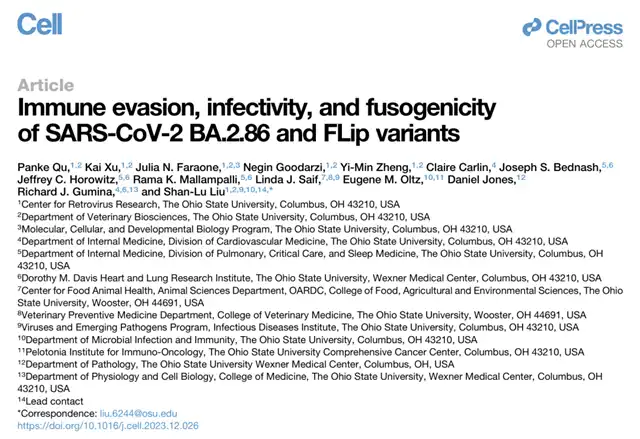Biological and Immune Escape Characteristics of SARS-CoV-2 Variant BA.2.86
- Normal Liver Cells Found to Promote Cancer Metastasis to the Liver
- Nearly 80% Complete Remission: Breakthrough in ADC Anti-Tumor Treatment
- Vaccination Against Common Diseases May Prevent Dementia!
- New Alzheimer’s Disease (AD) Diagnosis and Staging Criteria
- Breakthrough in Alzheimer’s Disease: New Nasal Spray Halts Cognitive Decline by Targeting Toxic Protein
- Can the Tap Water at the Paris Olympics be Drunk Directly?
Biological and Immune Escape Characteristics of SARS-CoV-2 Variant BA.2.86
- Should China be held legally responsible for the US’s $18 trillion COVID losses?
- CT Radiation Exposure Linked to Blood Cancer in Children and Adolescents
- FDA has mandated a top-level black box warning for all marketed CAR-T therapies
- Can people with high blood pressure eat peanuts?
- What is the difference between dopamine and dobutamine?
- How long can the patient live after heart stent surgery?
Biological and Immune Escape Characteristics of SARS-CoV-2 Variant BA.2.86 Explored by Ohio State University Researchers
Recent attention in the scientific community has focused on a newly identified subtype of SARS-CoV-2 named JN.1, which evolved from the Omicron BA.2.86 variant. Discovered in late July 2023 in Israel and Denmark, the BA.2.86 strain quickly spread globally, including in China. With over 30 mutations, BA.2.86 raised concerns about potentially causing a resurgence of the global COVID-19 pandemic similar to the early days of 2022. Fortunately, this fear has not materialized, and understanding the biological and immune escape characteristics of BA.2.86 is crucial.
On January 8, 2024, researchers from Ohio State University published a research paper titled “Immune Evasion, Infectivity, and Fusogenicity of SARS-CoV-2 BA.2.86 and FLip Variants” in the Cell journal, providing a comprehensive analysis of BA.2.86’s properties.
The team also investigated the FLip variant, originating from XBB.1.5 but with intriguing L455F and F456L mutations in the spike protein gene, enhancing its ability to evade neutralizing antibodies compared to XBB.1.5.

The study revealed significant differences in infectivity between BA.2.86 and previous Omicron strains. In 293T-ACE2 cells, BA.2.86 exhibited 1.8 to 2.1 times lower viral titers compared to all Omicron variants, including XBB.1.5 and EG.5.1. However, in human lung-derived epithelial CaLu-3 cells, BA.2.86’s viral titers were higher than all Omicron variants, increasing by 1.9 to 2.8 times compared to XBB.1.5, EG.5.1, and FLip, though still significantly lower than the D614G variant. This suggests that BA.2.86 may enhance the virulence for infecting human lung epithelial cells compared to other Omicron variants.
Notably, the researchers found that BA.2.86’s spike protein demonstrated low fusogenicity in 293T-ACE2 cells but significantly increased membrane fusion in CaLu-3 cells compared to any other Omicron strains, including XBB.1.5.
In terms of immune escape, the study evaluated the neutralizing effects of sera from 14 healthcare workers who received at least two doses of single mRNA vaccines and one booster dose against D614G and various Omicron subtypes, including BA.2.86. Despite BA.2.86’s neutralizing antibody efficacy being 12.8 times lower than D614G and approximately 11.7 times lower than BA.2, it was 1.7 to 5.5 times higher than the recent XBB lineage variants, indicating that BA.2.86 is more sensitive to sera from healthcare workers vaccinated with a bivalent vaccine, with FLip showing the highest resistance. These findings align with previous studies by David Ho, Dan Barouch, and Xuping Xie/Ping Ren.
Further investigations revealed that BA.2.86 and FLip exhibited reduced neutralization by antibodies induced by XBB.1.5 infection in 11 patients. While antibodies induced by XBB.1.5 infection had almost no neutralizing effect on BA.2.86 and FLip, BA.2.86 displayed a lower degree of immune evasion compared to XBB variants.
Surprisingly, the monoclonal antibody S309, effective against all Omicron subtypes, including XBB.1.5, EG.5.1, and FLip, showed no neutralizing effect on BA.2.86, possibly due to the D339H mutation in BA.2.86.

In conclusion, the study highlighted significant differences in the biological and immune escape characteristics of the recently emerged Omicron variants, BA.2.86 and FLip.
Compared to FLip and other XBB mutants, BA.2.86 demonstrated lower immune evasion, aligning with its antigenic similarity to early Omicron variants like BA.1, BA.2, and BA.4/5.
Importantly, BA.2.86 exhibited higher infectivity and membrane fusion in human lung epithelial cells than currently known Omicron strains.
However, whether this indicates enhanced pulmonary tropism and virulence in the new variant requires further investigation.
The research, led by Professor Liu Shanlu and his team at Ohio State University, received strong cooperation and support from Professor Richard J. Gumina and others at the university.
Biological and Immune Escape Characteristics of SARS-CoV-2 Variant BA.2.86 Explored by Ohio State University Researchers
(source:internet, reference only)
Disclaimer of medicaltrend.org
Important Note: The information provided is for informational purposes only and should not be considered as medical advice.



